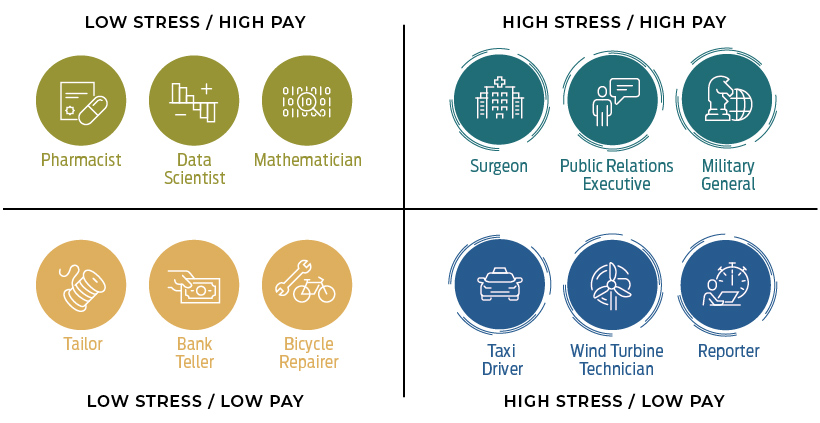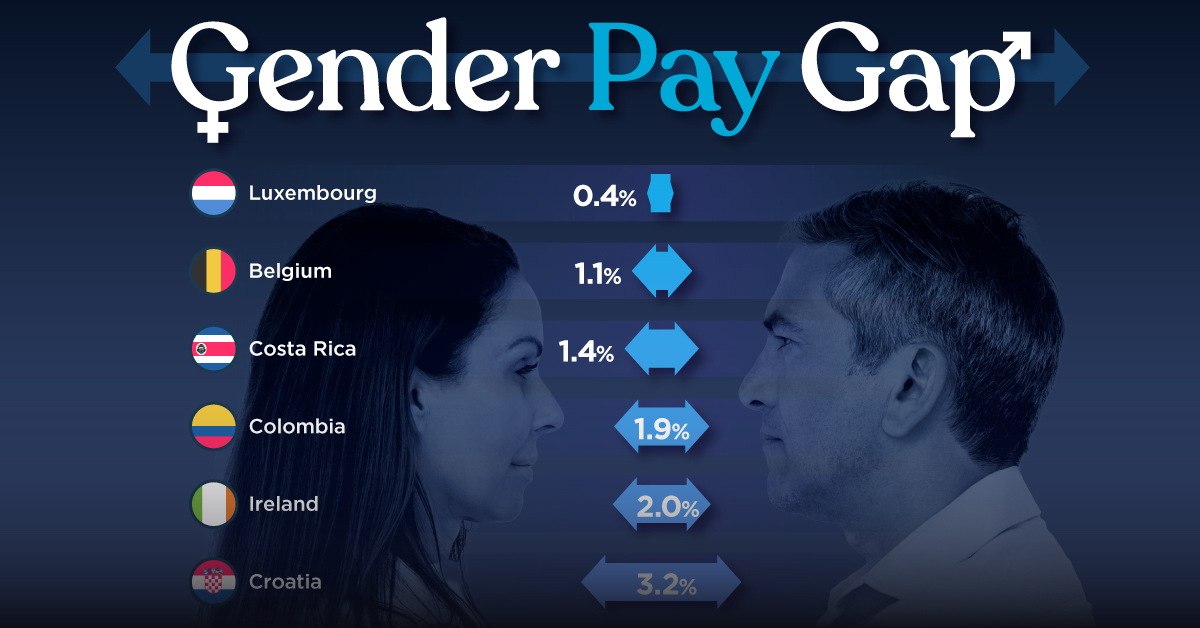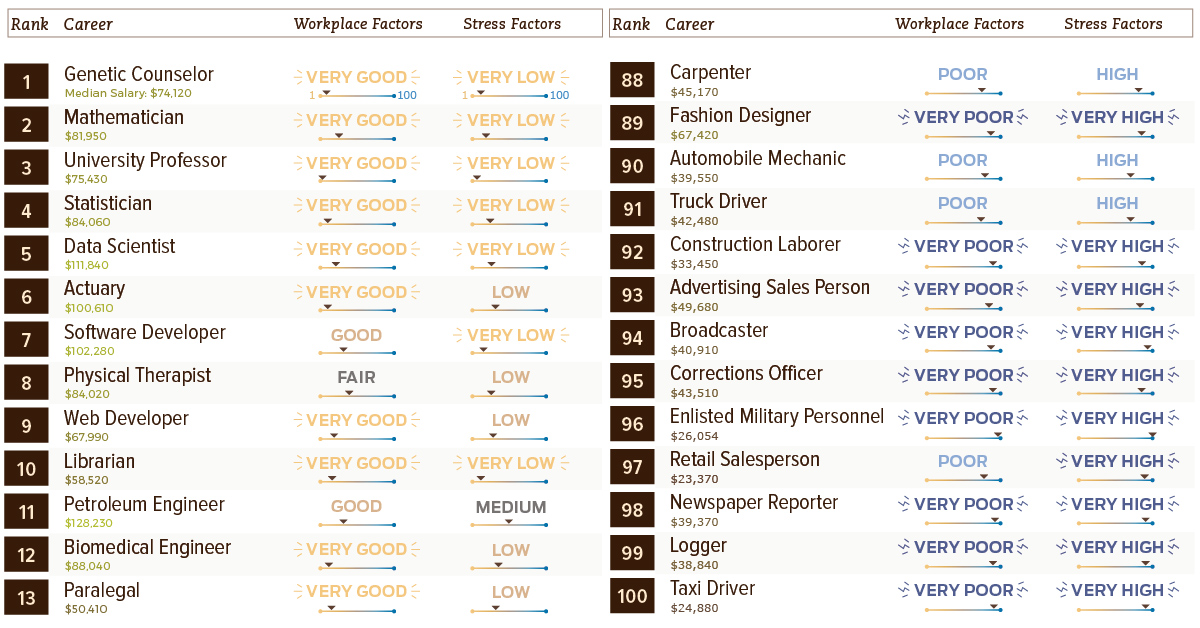Money
Visualizing the Ranking of 100 Common Careers
If you’re like most Americans, you probably spend more than 40 hours a week on the job.
For this reason, your career of choice plays a big role in determining your overall well-being. Not only does your profession have a massive influence on the potential money you make, but it also impacts your stress, work-life balance, happiness, and feeling of accomplishment.
However, it’s well-known that not all careers are created equally – and while some are stress-free with comfortable salaries, others can be high-stress without the compensation to make up for it.
Ranked: 100 Common Careers
Today’s chart uses data from the 2018 Jobs Rated Report by CareerCast.com, and we’ve used it to rank 100 of the most common careers based on median income, as well as three other categories: stress, growth outlook, and workplace environment.
The careers at the top of the list below have the best aggregate score, while the jobs towards the end of the list tend to be high-stress, low-income.

The 2018 Jobs Rated Report uses median income, as well as three other key categories to compile its rankings of common careers:
- Workplace:
A score based on the relative physical and mental demands for the job - Stress:
A weighting of 11 different stress factors, which range from “deadlines” to “own life at risk” - Growth Outlook:
Factors such as employment growth, income growth potential, and unemployment
See the full methodology here, for a more detailed explanation of the above categories.
Choosing the Optimal Career
If your goal is to maximize income, then traditional high-paying careers – like being a lawyer, doctor, investment banker, or senior corporate executive – are a good way to go.
For many people, however, a good career is defined as being more than just having high earning potential. Ideally, it’s also low-stress, while providing a healthy workplace that makes workers look forward to their jobs every day.
For people that think that way, it seems like being a pharmacist or a data scientist might present the best of both worlds:

At the same time, it may be safe to say that taxi drivers and reporters get the worst of both worlds: high stress and low pay.
Where does your occupation fall on the money/stress spectrum? Do you feel like the ranking above provides an accurate representation of your career?
Demographics
The Smallest Gender Wage Gaps in OECD Countries
Which OECD countries have the smallest gender wage gaps? We look at the 10 countries with gaps lower than the average.

The Smallest Gender Pay Gaps in OECD Countries
This was originally posted on our Voronoi app. Download the app for free on iOS or Android and discover incredible data-driven charts from a variety of trusted sources.
Among the 38 member countries in the Organization for Economic Cooperation and Development (OECD), several have made significant strides in addressing income inequality between men and women.
In this graphic we’ve ranked the OECD countries with the 10 smallest gender pay gaps, using the latest data from the OECD for 2022.
The gender pay gap is calculated as the difference between median full-time earnings for men and women divided by the median full-time earnings of men.
Which Countries Have the Smallest Gender Pay Gaps?
Luxembourg’s gender pay gap is the lowest among OECD members at only 0.4%—well below the OECD average of 11.6%.
| Rank | Country | Percentage Difference in Men's & Women's Full-time Earnings |
|---|---|---|
| 1 | 🇱🇺 Luxembourg | 0.4% |
| 2 | 🇧🇪 Belgium | 1.1% |
| 3 | 🇨🇷 Costa Rica | 1.4% |
| 4 | 🇨🇴 Colombia | 1.9% |
| 5 | 🇮🇪 Ireland | 2.0% |
| 6 | 🇭🇷 Croatia | 3.2% |
| 7 | 🇮🇹 Italy | 3.3% |
| 8 | 🇳🇴 Norway | 4.5% |
| 9 | 🇩🇰 Denmark | 5.8% |
| 10 | 🇵🇹 Portugal | 6.1% |
| OECD Average | 11.6% |
Notably, eight of the top 10 countries with the smallest gender pay gaps are located in Europe, as labor equality laws designed to target gender differences have begun to pay off.
The two other countries that made the list were Costa Rica (1.4%) and Colombia (1.9%), which came in third and fourth place, respectively.
How Did Luxembourg (Nearly) Eliminate its Gender Wage Gap?
Luxembourg’s virtually-non-existent gender wage gap in 2020 can be traced back to its diligent efforts to prioritize equal pay. Since 2016, firms that have not complied with the Labor Code’s equal pay laws have been subjected to penalizing fines ranging from €251 to €25,000.
Higher female education rates also contribute to the diminishing pay gap, with Luxembourg tied for first in the educational attainment rankings of the World Economic Forum’s Global Gender Gap Index Report for 2023.
See More Graphics about Demographics and Money
While these 10 countries are well below the OECD’s average gender pay gap of 11.6%, many OECD member countries including the U.S. are significantly above the average. To see the full list of the top 10 OECD countries with the largest gender pay gaps, check out this visualization.
-

 Technology2 weeks ago
Technology2 weeks agoRanked: The Most Popular Smartphone Brands in the U.S.
-

 Automotive1 week ago
Automotive1 week agoAlmost Every EV Stock is Down After Q1 2024
-

 Money1 week ago
Money1 week agoWhere Does One U.S. Tax Dollar Go?
-

 Green2 weeks ago
Green2 weeks agoRanked: Top Countries by Total Forest Loss Since 2001
-

 Real Estate2 weeks ago
Real Estate2 weeks agoVisualizing America’s Shortage of Affordable Homes
-

 Maps2 weeks ago
Maps2 weeks agoMapped: Average Wages Across Europe
-

 Mining2 weeks ago
Mining2 weeks agoCharted: The Value Gap Between the Gold Price and Gold Miners
-

 Demographics2 weeks ago
Demographics2 weeks agoVisualizing the Size of the Global Senior Population













